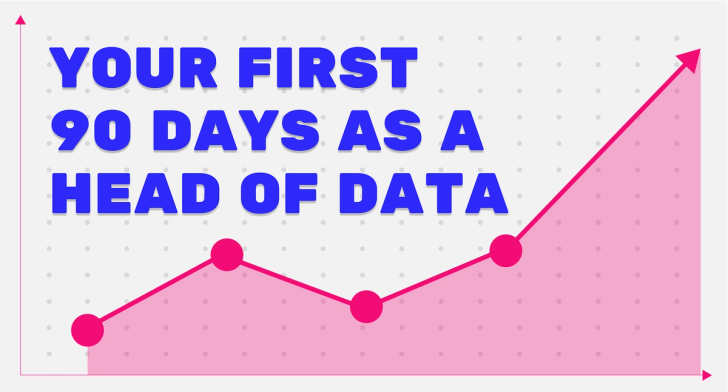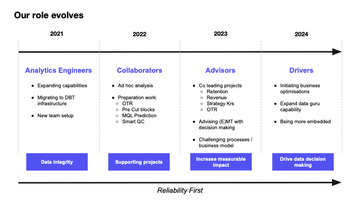Your First 90 Days as a Head of Data
“I started as Head of Data at a new company in September, and it’s been a really challenging experience. I came in thinking it would be different because they used different tools, or because it’s a different type of business, but it was so much more than that.” - Anonymous
Starting a new role in any organization is difficult, and joining as a new data leader comes with its own unique challenges. Inspired by the leadership bookThe First 90 Daysby Michael Watkins, I recently asked some Heads of Datawhat should a Head of Data do in their first 90 days on the job to make sure they’re starting strong.
Thanks to the following for your input!
- , Head of Data at GoHenry
- , Insights Director at
- , Head of Data at Runa
- , Director of Data Science at REMERGE
- Group Head Data and Insights at TLC Marketing
- , Head of Data at Zenjob

What makes this challenging?
New tools, processes, stakeholders in every part of the business, entrenched beliefs and opinions, and unspoken expectations. The things that make it difficult to begin as a Head of Data are the same things that make it difficult to thrive as a Head of Data. This role is uniquely balanced between technical and non-technical domains, and requires knowing the right time to listen to your stakeholders, and when to say ‘no’. In short, it’s a tough job at any point, so it’s no wonder the first 90 days can be particularly challenging.
The following is advice I’ve collected from several Heads of Data over the last few weeks on how to make this transition as expertly as possible.

1. First, listen
It might sound intuitive, but your first few weeks should be all about putting your listening skills to the test. This means reserving your opinions and agendas until you’ve received a solid foundation of base knowledge.
“I spent the first 2-3 weeks meeting as many people as possible and listening, digging into the systems and documentation, and absorbing information.” - Toby Ayre, Head of Data at GoHenry
Specifically, these first two weeks of listening should consist of actively setting up meetings with a wide variety of stakeholders, leaders, and everyone on your team.
When meeting with business leaders, you should seek to understand:
- their responsibilities - what are they being asked to deliver?
- what they need to do their jobs
- what their drivers are
- what are their perceptions/opinions of the data team, tooling, and processes
- what are some quick wins you could deliver for them?
“My one tip would be to understand drivers and perceptions from the rest of the senior leadership team in those first few weeks. Yes, build trust and connection, butfind out what they. What are their objectives and how do you fit into that.” - Alan Cruickshank, Insights Director at tails.com
As Alan notes above, the purpose of this process isn’t only to gather information, but to start building trust with your stakeholders as quickly as possible. These relationships are essential to long-term success.
What gathering data looks like
For many leaders, this means setting up 1:1’s with as many business leaders and stakeholders as possible in the first few weeks. Take good notes after each session (even record them if people are OK with it, but make it clear it’s only for your note-taking purposes).
To scale this activity, some folks, like Lina Mikolajczyk of Bumble, will also run a business-wide survey in the first few weeks. This greatly increases the amount of data you have with which to identify patterns and issues, but less of the individual relationship-building. See ourplaybook on Stakeholder surveysto see more details on how that works.
2. Assess and make a plan
Poised with a wealth of information, it’s now time to decide what you’re going to do. Making an effective data roadmap calls for its own article, but until that’s available, it’s helpful to think through the following:
- Today’s strengths and weaknesses
- Today’s challenges and frequent requests
- What are the critical things that need to be done (e.g. those quarterly business updates that are critically important for execs)
- The ideal state - where you want to be one day
- What milestones will you help you and others know you’re making meaningful progress towards that goal?

Make sure you explain the ‘why’
People must see not just what you’re going to do bywhyyou’re doing it, andhow it impacts them:
“I would try to get closer to the root cause of “why a change is needed” and “why the change is not done previously”. So that I am clearer about the goal and challenges ahead - in some cases it’s better to clarify the goals and reprioritise the wanted list if that’s unrealistic.” - Jacky Ma, Director of Data Science at REMERGE
3. Set clear expectations
Use this time as a new leader to reset expectations with the rest of the organization. This can mean resetting the understanding of what a data team is (e.g. not just a dashboard factory):
“When you join there's usually all kinds of tech debt and misunderstanding around what a Data team is actually supposed to do, and the longer you leave it to address those things the harder it will be to untangle.” - Matt Hawkins, Head of Data at Runa
This also means making sure people understand what you need from them (e.g. implementing a new process for taking ad-hoc requests, or assigning business owners of certain data sets).
These new expectations are in effect a new contract with the rest of the business, and it’s important to follow through on your side of the deal:
“Upon your entry into the organization, many of the other roles around you will have a huge range of expectations of you (some said, some unsaid) - you can’t prevent those expectations, all you can do is either deliver on them, or reset them before they lead to disappointment., and it’s much better to under promise and over deliver and build trust rather than promising the world and only delivering half of it.” - Alan Cruickshank
Don’t be afraid to be the bad guy
Getting buy-in and support doesn’t mean you do whatever the rest of the business asks for. Saying no, or making unpopular changes is also part of the job, and one you can’t be afraid to do.
“Err on the side of being the bad guy. I don't regret any of the bad-guy moves I made in my first three months (e.g. ditchingBI tools that a few people were using and initially sad to lose, but were badly set up and didn't fit with our strategy; ripping up our data modelling and rebuilding in dbt), but I do regret the times I was overly cautious and shied away from necessary (but hard) change.” - Matt Hawkins
Again, being able to explainwhyyou are making these ‘bad guy’ decisions can make a significant difference in how they are received by the rest of the organization.
What this practically looks like
Use your roadmap to frame your conversations around expectations. Go into each business unit’s all-hands (or similar) and introduce yourself, and your roadmap, and make sure you talk through these new expectations.
Then, as Alan says, make sure you deliver.
4. Look for easy wins
“With any new data team an advantage is to have somelow hanging wins.” - Amita Prashar, Group Head Data and Insights at TLC Marketing
A key to maintaining the trust and respect you have (hopefully) earned over your first few months is to show early progress. This means prioritizing at least a few quick wins in that time.
Look back on your early conversations for inspiration, but remember this isn’t all aboutbuilding. Many quick wins have to do with removing things they don’t like (e.g. complicated data request forms), or adding more visibility to things:
“I created a team called ‘Data squad’ which involved some decision makers from different teams and countries who would be aligned to a common vision and add on their data related achievements/milestones along the way. This bought more visibility across business for the Data team.” - Amita Prashar
Just don’t forget to communicate when you deliver these quick wins or all that goodwill you just banked will be wasted.
One last thing
If there’s one thing I’ve learned in the last few months in all my conversations with data leaders is that it can be an incredibly lonely position. So if you’re feeling overwhelmed, or indeed, lonely, in your first few months on the job, you’re not alone. Almost everyone I speak to feels that way too. But data leaders are also a very welcoming and helpful bunch, so my last piece of advice isdon’t be afraid to ask for help.
If you don’t know anyone to reach out to for help, feel free to drop me a message on LinkedIn and I can see if I can help connect you with someone.
Resources
- by Michael Watkins
- by Caroline Carruthers and Peter Jackson